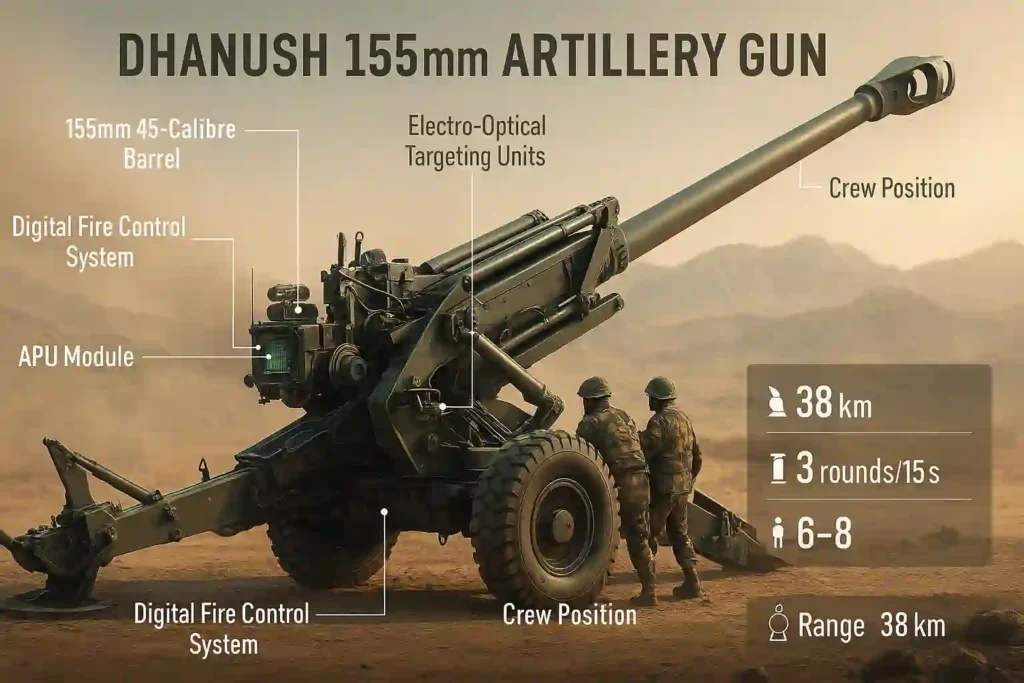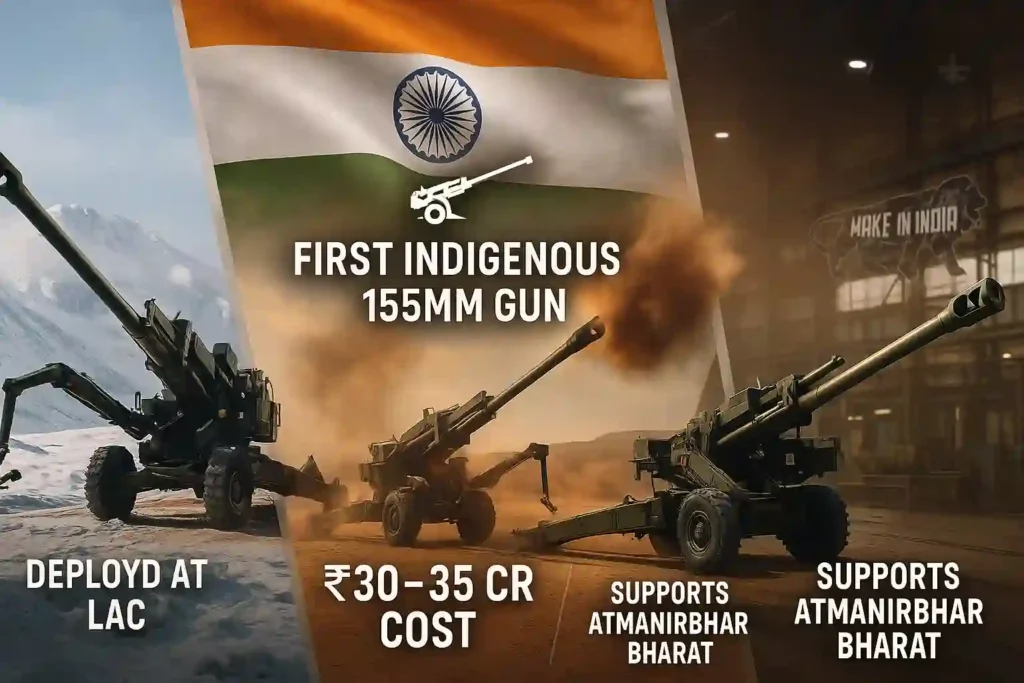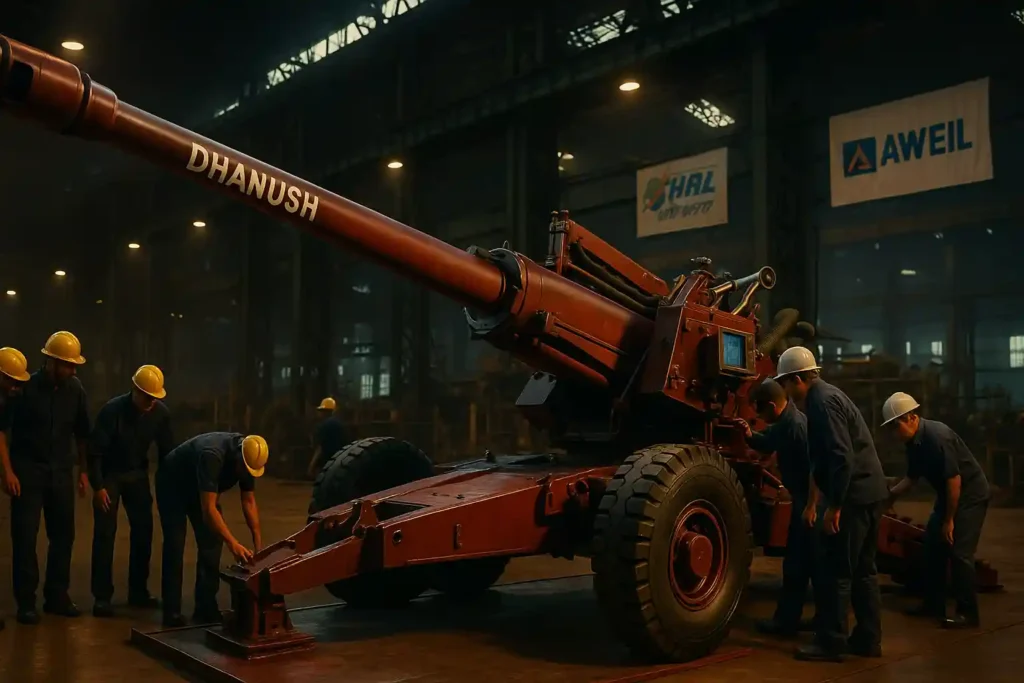As of 20th June 2025, the Indian Army has officially inducted its third regiment of Dhanush artillery guns, marking a significant leap in indigenous defence capability and battlefield readiness.
The Dhanush artillery gun isn’t just an upgraded Bofors—it is India’s first fully indigenous 155mm towed howitzer, purpose-built for long-range precision, high mobility, and reliable performance across extreme terrains. With digital fire control systems, a firing range of up to 38 km, and deployment in high-altitude warfare zones like Ladakh, Dhanush is actively reshaping India’s artillery doctrine.
This article covers everything you need to know about the Dhanush gun system—from its specifications, production journey, and battlefield deployment to the future variants that may define India’s long-range firepower for years to come.
What is the Dhanush Artillery Gun?

The Dhanush howitzer is a 155mm/45-calibre towed artillery gun developed under the ‘Make in India’ initiative, originally conceptualised by the Ordnance Factory Board (OFB) and now produced by Advanced Weapons and Equipment India Limited (AWEIL).
While its design lineage traces back to the Swedish Bofors FH-77B, the Dhanush integrates modern upgrades in firing range, digital navigation, automation, and mobility, making it a much more advanced and battlefield-ready 155mm gun system tailored to India’s defence requirements.
With an effective range of up to 38 km using ERFB-BB ammunition, automated sighting, and over 80% indigenous components, the Dhanush represents India’s first fully homegrown long-range artillery platform.
Key Features That Define the Dhanush Gun’s Superiority

- 155mm calibre and 45-calibre barrel: Delivers high-velocity projectiles for deeper target penetration and extended range.
- Extended firing range of 36–38 km: Enabled by base-bleed shells, making it ideal for deep-strike missions and high-altitude combat.
- Digital fire control system: Includes inertial navigation, GPS-based auto-laying, and onboard ballistic computing for pinpoint accuracy.
- Self-propelled mobility: Built-in APU allows limited movement without a towing vehicle—essential for fast repositioning during engagements.
- All-weather, round-the-clock targeting: Integrated with advanced electro-optical sights and thermal imaging systems, enabling precise engagement during both day and night, even in low-visibility or harsh weather conditions.
- High firing rate: Capable of firing 3 shells in 15 seconds (burst mode) and up to 60 rounds per hour in sustained operations.
- Efficient crew management: Operated by a crew of 6–8 personnel with semi-automatic loading for improved speed and reduced fatigue.
Why Dhanush Matters in India’s Defence Strategy

- First indigenous long-range artillery gun: India has made a significant breakthrough in its pursuit of self-reliant defence systems.
- Proven deployment in Ladakh and eastern sectors: Demonstrated real-world effectiveness during high-altitude tensions at the Line of Actual Control (LAC).
- Strategic deterrence: Enhances India’s fire dominance in contested regions like Arunachal, Ladakh, and the western front.
- Dhanush artillery gun price: Estimated at ₹30–35 crore, offering powerful capabilities at nearly half the cost of imported systems such as Caesar or M777.
- Boost to Make in India defence manufacturing: Dhanush directly supports local supply chains and accelerates indigenous capability development.
Production and Induction Timeline

- Concept phase: Initiated in 2010 using licensed technology from Bofors.
- Final trials completed: 2014
- Bulk production cleared: 2019
- Manufactured by: Gun Carriage Factory (GCF), Jabalpur—now under AWEIL
- Induction milestones:
- 1st Regiment: Operational since 2021
- 2nd Regiment: Inducted mid-2023
- 3rd Regiment: Inducted on 20th June 2025
- Total units ordered: 114 Dhanush howitzers; full delivery expected by late 2026
Current Performance and Battlefield Deployment
The Dhanush has been deployed in high-altitude zones and desert sectors alike, proving itself across India’s most challenging operational environments.

It played a key role during standoffs with China by providing long-range deterrence and enabling flexible artillery responses. Its self-mobility feature via the APU gives it an edge in quick deployment and repositioning, especially in fast-moving border scenarios.
Future Variants and Upgrades in the Dhanush Project
- Dhanush 52-calibre variant: In development to match NATO standards with a projected range of 42–45 km.
- Mounted Gun System (MGS): A wheeled version currently under trial to deliver faster deployment and “shoot-and-scoot” capabilities.
- Precision-guided artillery rounds: Upcoming compatibility with ramjet-assisted and GPS-guided shells to push range beyond 60 km.
Dhanush vs ATAGS: Complement, Not Competition
While the ATAGS (Advanced Towed Artillery Gun System) boasts extended range (~48–52 km) and next-gen automation, it is still undergoing evaluations. The Dhanush artillery gun, by contrast, is already battle-tested, cost-effective, and fully inducted into active service.

Dhanush offers ruggedness, easier maintenance, and quicker deployment, making it the ideal interim backbone system as India transitions to more futuristic artillery platforms.
Commonly Asked Questions
1. What calibre is the Dhanush howitzer?
It’s a 155mm, 45-calibre towed artillery gun, designed for long-range field operations and high-altitude adaptability.
2. What is the cost of the Dhanush artillery gun?
Estimated at ₹30–35 crore per unit, it is significantly more affordable than foreign equivalents while offering modern capabilities.
3. Is Dhanush better than Bofors?
Yes. It delivers greater range, digital systems, better accuracy, and is indigenously produced, making it a major upgrade over the original Bofors FH-77B.
Final Word: A Symbol of India’s Indigenous Firepower
With three Dhanush gun regiments now active as of June 2025, India has achieved a major milestone in artillery self-reliance. From high-altitude warfare in Ladakh to precision strikes in desert terrain, the Dhanush artillery gun proves its mettle across every battlefield.
And as the Army prepares to induct its next-generation upgrades, one thing is clear—Dhanush isn’t just made in India, it’s made for India’s defence future.
